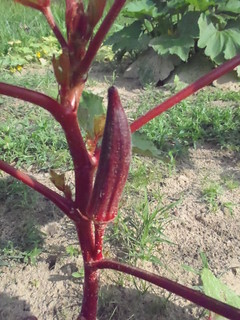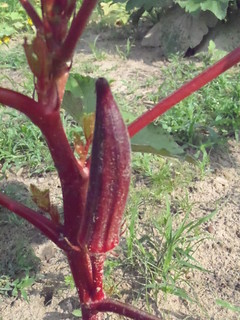What to do?
Make fritters or pickles: video: Continue reading
Is this why they call them lady fingers?
Maybe eat them raw, or cook them tonight; video:
Continue readingPicked some more purple okra today, plus a beet, and plenty of green okra. Here are some of those compared with an orange okra. The purple okra on the left is the one from yesterday’s color wheel; it was picked smaller than these today, and looks almost black with some green. The ones today look more purple, somewhere between beet and fuschia; maybe red violet. The orange okra (same one from yesterday) looks red-orange or maroon with a bit of green. And the green okra looks, well, green.
Flash:
Continue readingMore orange okra coming along:


Pictures by Gretchen Quarterman for Okra Paradise Farms, Lowndes County, Georgia, 2013-06-27.
Soon we’ll compare to the purple okra.
-jsq
It turns out that okra pod from Monday was actually a stray green okra, not purple at all. But this, this is a purple okra. And another….
Three, Four, Five: Continue reading
Francine out for a walk between the creek and the house:
Species Profile: Florida Softshell (Apalone ferox) | SREL Herpetology
Like other softshells, the Florida softshell turtle (Apalone ferox) is a large, flat turtle with skin covering its shell (resembling a pancake). It is the bulkiest of the softshell turtles but inhabits the smallest range. It varies in size with males measuring from 6-12 inches (15-30 cm) and females measuring double that at 11-24 inches (28-61 cm). Adults are usually colored by a dark brown to brownish-gray with dark spots. Also there are usually small dark bumps on the carapace. In juveniles these dark bumps on the carapace are much more easily seen, as they are usually lighter in color than the adults. The carapace of the Florida softshell is covered with longitudinal rows of tubercles that resemble ridges in younger turtles but are less evident in larger turtles. In adult turtles the plastron of the shell usually extends farther than the carapace.Continue reading